Efficient Photo-Driven Electron Transfer from Amino Group-Decorated Adamantane to Water
Abstract
1. Introduction
2. Results
2.1. Electronic Properties of Amino-Functionalized Adamantane
2.2. Charge Transfer to Water Dimers
2.3. Charge Transfer to Water Dimers in Proximity
2.4. Charge Transfer to Water Molecules Within the Solvation Shell
3. Theory and Methods
3.1. Electronic Structure Calculations
3.2. Molecular Dynamic Simulations
4. Conclusions
Author Contributions
Funding
Institutional Review Board Statement
Informed Consent Statement
Data Availability Statement
Acknowledgments
Conflicts of Interest
Appendix A
| Atom | X | Y | Z |
|---|---|---|---|
| C | −0.26012 | 0.00000 | 1.50157 |
| C | 1.28888 | −0.01809 | 1.46912 |
| C | 1.81839 | 1.23647 | 0.75085 |
| C | 1.79424 | −1.27426 | 0.73188 |
| C | −0.80559 | 0.00000 | 0.00000 |
| C | 1.29996 | 1.26362 | −0.69938 |
| C | 1.28301 | −1.26520 | −0.72145 |
| C | −0.27047 | −1.31433 | −0.74716 |
| C | −0.25417 | 1.33188 | −0.76265 |
| C | 1.79612 | 0.00490 | −1.43526 |
| N | −0.72494 | 1.21580 | 2.19689 |
| N | −0.72275 | −1.21019 | 2.23315 |
| H | 1.65393 | −0.03150 | 2.50872 |
| H | 2.91690 | 1.20887 | 0.74509 |
| H | 1.52961 | 2.14134 | 1.29244 |
| H | 1.47769 | −2.18425 | 1.25083 |
| H | 2.89227 | −1.27328 | 0.72853 |
| N | −2.27358 | 0.04046 | 0.04692 |
| H | 1.66101 | 2.15977 | −1.21379 |
| H | 1.65613 | −2.16345 | −1.24021 |
| N | −0.72165 | −1.34732 | −2.15932 |
| N | −0.87230 | −2.51389 | −0.13860 |
| N | −0.69825 | 2.60405 | −0.18562 |
| N | −0.67312 | 1.40890 | −2.16211 |
| H | 2.89480 | −0.00638 | −1.44780 |
| H | 1.46132 | 0.03630 | −2.47627 |
| H | −2.61452 | −0.92277 | 0.05531 |
| H | −2.60265 | 0.44797 | −0.82970 |
| H | −1.38307 | 2.11902 | −2.29801 |
| H | −0.92560 | 0.50192 | −2.54862 |
| H | −0.46708 | 2.61517 | 0.80656 |
| H | −1.71953 | 2.62010 | −0.20607 |
| H | −1.60758 | −1.85003 | −2.17759 |
| H | −0.06316 | −1.89269 | −2.71387 |
| H | −0.66134 | −2.55454 | 0.86029 |
| H | −0.49104 | −3.33998 | −0.60039 |
| H | −0.51891 | 1.12070 | 3.19163 |
| H | −1.74092 | 1.24678 | 2.09664 |
| H | −1.73552 | −1.14811 | 2.34296 |
| H | −0.33125 | −1.18213 | 3.17557 |
| O | −5.42045 | −0.07161 | −1.54517 |
| H | −5.42045 | −0.06665 | −0.59887 |
| H | −5.42045 | 0.84285 | −1.78865 |
| O | −5.42045 | −0.07161 | 1.37114 |
| H | −4.67166 | 0.18477 | 1.88988 |
| H | −6.16925 | 0.18477 | 1.88988 |
References
- Friedlingstein, P.; O’Sullivan, M.; Jones, M.W.; Andrew, R.M.; Hauck, J.; Olsen, A.; Peters, G.P.; Peters, W.; Pongratz, J.; Sitch, S.; et al. Global Carbon Budget 2020. Earth Syst. Sci. Data Discuss. 2020, 2020, 1–3. [Google Scholar] [CrossRef]
- Su, L.X.; Cao, Y.; Hao, H.S.; Zhao, Q.; Zhi, J. Emerging Applications of Nanodiamonds in Photocatalysis. Funct. Diam. 2022, 1, 93–109. [Google Scholar] [CrossRef]
- Nadeem, N.; Zahid, M.; Abbas, Q.; Jilani, A. Carbon-Based Materials: Powering the Future of Energy and Environmental Progress. Front. Chem. 2024, 12, 1481960. [Google Scholar] [CrossRef]
- Hazen, R.M.; Hemley, R.J.; Mangum, A.J. Carbon in Earth’s Interior: Storage, Cycling, and Life. Eos Trans. Am. Geophys. Union 2012, 93, 17–18. [Google Scholar] [CrossRef]
- Danilenko, V.V. On the History of the Discovery of Nanodiamond Synthesis. Phys. Solid State 2004, 46, 595–599. [Google Scholar] [CrossRef]
- Yang, G.W.; Wang, J.B.; Liu, Q.X. Preparation of Nano-Crystalline Diamonds Using Pulsed Laser Induced Reactive Quenching. J. Phys. Condens. Matter 1998, 10, 7923. [Google Scholar] [CrossRef]
- Frenklach, M.; Howard, W.; Huang, D.; Yuanwen, J.; Spear, K.E.; Koba, R. Induced Nucleation of Diamond Powder. Appl. Phys. Lett. 1991, 59, 546–548. [Google Scholar] [CrossRef]
- Boudou, J.P.; Curmi, P.A.; Jelezko, F.; Wrachtrup, J.; Aubert, P.; Sennour, M.; Balasubramanian, G.; Reuter, R.; Thorel, A.; Gaffet, E. High-Yield Fabrication of Fluorescent Nanodiamonds. Nanotechnology 2009, 20, 235602. [Google Scholar] [CrossRef] [PubMed]
- Bagheri, S.; Julkapli, N.M. Nanodiamond-Based Photocatalysis for Solar Hydrogen Production. Int. J. Hydrogen Energy 2020, 45, 31538–31554. [Google Scholar] [CrossRef]
- Gao, X.; Han, X.; Zhao, Z.; Huang, N.; Jiao, K.; Song, P.; Zhu, J.; Wang, Y. Lewis Functional Nanodiamonds for Efficient Metal-Free Photocatalytic CO2 Reduction. J. Mater. Chem. A 2024, 12, 32745–32759. [Google Scholar] [CrossRef]
- Zhu, D.; Zhang, L.; Ruther, R.E.; Hamers, R.J. Photo-Illuminated Diamond as a Solid-State Source of Solvated Electrons in Water for Nitrogen Reduction. Nat. Mater. 2013, 12, 836–841. [Google Scholar] [CrossRef]
- Paci, J.T.; Man, H.B.; Saha, B.; Ho, D.; Schatz, G.C. Understanding the Surfaces of Nanodiamonds. J. Phys. Chem. C 2013, 117, 17256–17267. [Google Scholar] [CrossRef]
- Galli, G. Structure, Stability and Electronic Properties of Nanodiamonds; Springer: Berlin/Heidelberg, Germany, 2010. [Google Scholar]
- Su, S.; Li, J.; Kundrát, V.; Abbot, A.M.; Ye, H. Hydrogen-Terminated Detonation Nanodiamond: Impedance Spectroscopy and Thermal Stability Studies. J. Appl. Phys. 2013, 113, 023707. [Google Scholar] [CrossRef]
- Drummond, N.; Williamson, A.; Needs, R.; Galli, G. Electron emission from diamondoids: A diffusion quantum Monte Carlo study. Phys. Rev. Lett. 2005, 95, 096801. [Google Scholar] [CrossRef]
- Mochalin, V.; Shenderova, O.; Ho, D.; Gogotsi, Y. The Properties and Applications of Nanodiamonds. In Nano-Enabled Medical Applications; Jenny Stanford Publishing: Singapore, 2020; pp. 313–350. [Google Scholar]
- Yamaguchi, H.; Masuzawa, T.; Nozue, S.; Kudo, Y.; Saito, I.; Koe, J.; Kudo, M.; Yamada, T.; Takakuwa, Y.; Okano, K. Electron emission from conduction band of diamond with negative electron affinity. Phys. Rev. B—Condens. Matter Mater. Phys. 2009, 80, 165321. [Google Scholar] [CrossRef]
- Tafel, A.; Meier, S.; Ristein, J.; Hommelhoff, P. Femtosecond laser-induced electron emission from nanodiamond-coated tungsten needle tips. Phys. Rev. Lett. 2019, 123, 146802. [Google Scholar] [CrossRef]
- Alkahtani, M.H.; Alghannam, F.; Jiang, L.; Almethen, A.; Rampersaud, A.A.; Brick, R.; Gomes, C.L.; Scully, M.O.; Hemmer, P.R. Fluorescent nanodiamonds: Past, present, and future. Nanophotonics 2018, 7, 1423–1453. [Google Scholar] [CrossRef]
- Zhang, X.; Wei, S.; Ji, Q. Preparation of Nanodiamond Film by Sol–Gel Coating Method for Field Emission Display. Adv. Nanoparticles 2017, 6, 1–9. [Google Scholar] [CrossRef]
- Buchner, F.; Kirschbaum, T.; Venerosy, A.; Girard, H.; Arnault, J.C.; Kiendl, B.; Krueger, A.; Larsson, K.; Bande, A.; Petit, T.; et al. Early Dynamics of the Emission of Solvated Electrons from Nanodiamonds in Water. Nanoscale 2022, 14, 17188–17195. [Google Scholar] [CrossRef]
- Maier, F.; Ristein, J.; Ley, L. Electron Affinity of Plasma-Hydrogenated and Chemically Oxidized Diamond (100) Surfaces. Phys. Rev. B 2001, 64, 165411. [Google Scholar] [CrossRef]
- Zhang, L.; Zhu, D.; Nathanson, G.M.; Hamers, R.J. Selective Photoelectrochemical Reduction of Aqueous CO2 to CO by Solvated Electrons. Angew. Chem. 2014, 126, 9904–9908. [Google Scholar] [CrossRef]
- Wang, X.; Krause, P.; Kirschbaum, T.; Palczynski, K.; Dzubiella, J.; Bande, A. Photo-excited charge transfer from adamantane to electronic bound states in water. Phys. Chem. Chem. Phys. 2024, 26, 8158–8176. [Google Scholar] [CrossRef]
- Kirschbaum, T.; von Seggern, B.; Dzubiella, J.; Bande, A.; Noé, F. Machine Learning Frontier Orbital Energies of Nanodiamonds. J. Chem. Theory Comput. 2022, 19, 4461–4473. [Google Scholar] [CrossRef]
- Gueymard, C.A. The Sun’s Total and Spectral Irradiance for Solar Energy Applications and Solar Radiation Models. Sol. Energy 2004, 76, 423–453. [Google Scholar] [CrossRef]
- Kim, J.; Suh, S.B.; Kim, K.S. Water Dimer to Pentamer with an Excess Electron: Ab Initio Study. J. Chem. Phys. 1999, 111, 10077–10087. [Google Scholar] [CrossRef]
- Yu, J.; Su, N.Q.; Yang, W. Describing chemical reactivity with frontier molecular orbitalets. JACS Au 2022, 2, 1383–1394. [Google Scholar] [CrossRef]
- Nazarov, V.U. Breakdown of the Ionization Potential Theorem of Density Functional Theory in Mesoscopic Systems. J. Chem. Phys. 2021, 155, 194105. [Google Scholar] [CrossRef]
- Perdew, J.P.; Levy, M. Physical Content of the Exact Kohn-Sham Orbital Energies: Band Gaps and Derivative Discontinuities. Phys. Rev. Lett. 1983, 51, 1884–1887. [Google Scholar] [CrossRef]
- Levy, M.; Perdew, J.P.; Sahni, V. Exact Differential Equation for the Density and Ionization Energy of a Many-Particle System. Phys. Rev. A 1984, 30, 2745–2754. [Google Scholar] [CrossRef]
- Winter, B.; Weber, R.; Widdra, W.; Dittmar, M.; Faubel, M.; Hertel, I.V. Full Valence Band Photoemission from Liquid Water Using EUV Synchrotron Radiation. J. Phys. Chem. A 2004, 108, 2625–2632. [Google Scholar] [CrossRef]
- Gaiduk, A.P.; Pham, T.A.; Govoni, M.; Paesani, F.; Galli, G. Electron Affinity of Liquid Water. Nat. Commun. 2018, 9, 1–6. [Google Scholar] [CrossRef]
- Miliaieva, D.; Djoumessi, A.S.; Čermák, J.; Kolářová, K.; Schaal, M.; Otto, F.; Shagieva, E.; Romanyuk, O.; Pangrác, J.; Kuliček, J.; et al. Absolute energy levels in nanodiamonds of different origins and surface chemistries. Nanoscale Adv. 2023, 5, 4402–4414. [Google Scholar] [CrossRef]
- Nordlund, D.; Ogasawara, H.; Bluhm, H.; Takahashi, O.; Odelius, M.; Nagasono, M.; Pettersson, L.G.M.; Nilsson, A. Probing the Electron Delocalization in Liquid Water and Ice at Attosecond Time Scales. Phys. Rev. Lett. 2007, 99, 217406. [Google Scholar] [CrossRef]
- Jesus, A.L.; Redinha, J. Molecular insight into the amine–water interaction: A combined vibrational, energetic and NBO/NEDA study. Comput. Theor. Chem. 2013, 1023, 74–82. [Google Scholar] [CrossRef]
- Yanai, T.; Tew, D.P.; Handy, N.C. A New Hybrid Exchange–Correlation Functional Using the Coulomb-Attenuating Method (CAM-B3LYP). Chem. Phys. Lett. 2004, 393, 51–57. [Google Scholar] [CrossRef]
- Dunning, T.H., Jr. Gaussian Basis Sets for Use in Correlated Molecular Calculations. I. The Atoms Boron Through Neon and Hydrogen. J. Chem. Phys. 1989, 90, 1007–1023. [Google Scholar] [CrossRef]
- Kendall, R.A.; Dunning, T.H., Jr.; Harrison, R.J. Electron Affinities of the First-Row Atoms Revisited: Systematic Basis Sets and Wave Functions. J. Chem. Phys. 1992, 96, 6796–6806. [Google Scholar] [CrossRef]
- Grimme, S.; Antony, J.; Ehrlich, S.; Krieg, H. A consistent and accurate ab initio parametrization of density functional dispersion correction (DFT-D) for the 94 elements H-Pu. J. Chem. Phys. 2010, 132, 154104. [Google Scholar] [CrossRef]
- Barone, V.; Cossi, M. Quantum calculation of molecular energies and energy gradients in solution by a conductor solvent model. J. Phys. Chem. A 1998, 102, 1995–2001. [Google Scholar] [CrossRef]
- Neese, F. Software Update: The ORCA Program System, Version 4.0. Wiley Interdiscip. Rev. Comput. Mol. Sci. 2018, 8, 1327. [Google Scholar] [CrossRef]
- Lu, T.; Chen, F. Multiwfn: A Multifunctional Wavefunction Analyzer. J. Comput. Chem. 2012, 33, 580–592. [Google Scholar] [CrossRef]
- Martin, R.L. Natural Transition Orbitals. J. Chem. Phys. 2003, 118, 4775–4777. [Google Scholar] [CrossRef]
- Hirshfeld, F.L. Bonded-Atom Fragments for Describing Molecular Charge Densities. Theor. Chim. Acta 1977, 44, 129–138. [Google Scholar] [CrossRef]
- Abraham, M.J.; Murtola, T.; Schulz, R.; Páll, S.; Smith, J.C.; Hess, B.; Lindahl, E. GROMACS: High performance molecular simulations through multi-level parallelism from laptops to supercomputers. SoftwareX 2015, 1, 19–25. [Google Scholar] [CrossRef]
- Wang, J.; Wang, W.; Kollman, P.A.; Case, D.A. Automatic atom type and bond type perception in molecular mechanical calculations. J. Mol. Graph. Model. 2006, 25, 247–260. [Google Scholar] [CrossRef]
- Jorgensen, W.L.; Chandrasekhar, J.; Madura, J.D.; Impey, R.W.; Klein, M.L. Comparison of simple potential functions for simulating liquid water. J. Chem. Phys. 1983, 79, 926–935. [Google Scholar] [CrossRef]
- Parrinello, M.; Rahman, A. Polymorphic transitions in single crystals: A new molecular dynamics method. J. Appl. Phys. 1981, 52, 7182–7190. [Google Scholar] [CrossRef]
- Bennett, L.; Melchers, B.; Proppe, B. Curta: A General-Purpose High-Performance Computer at ZEDAT, Freie Universität Berlin; Freie Universität: Berlin, Germany, 2020. [Google Scholar]
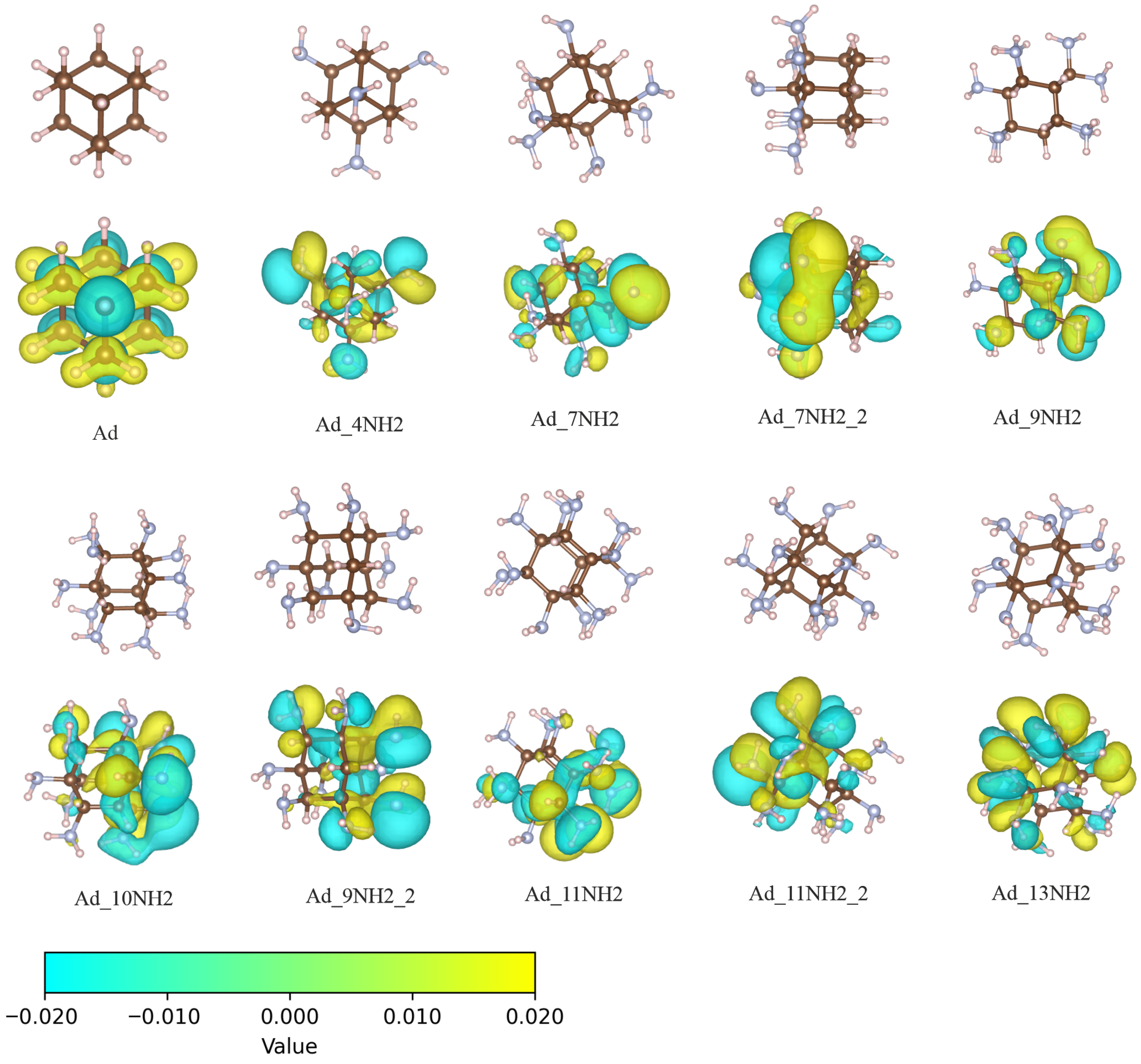
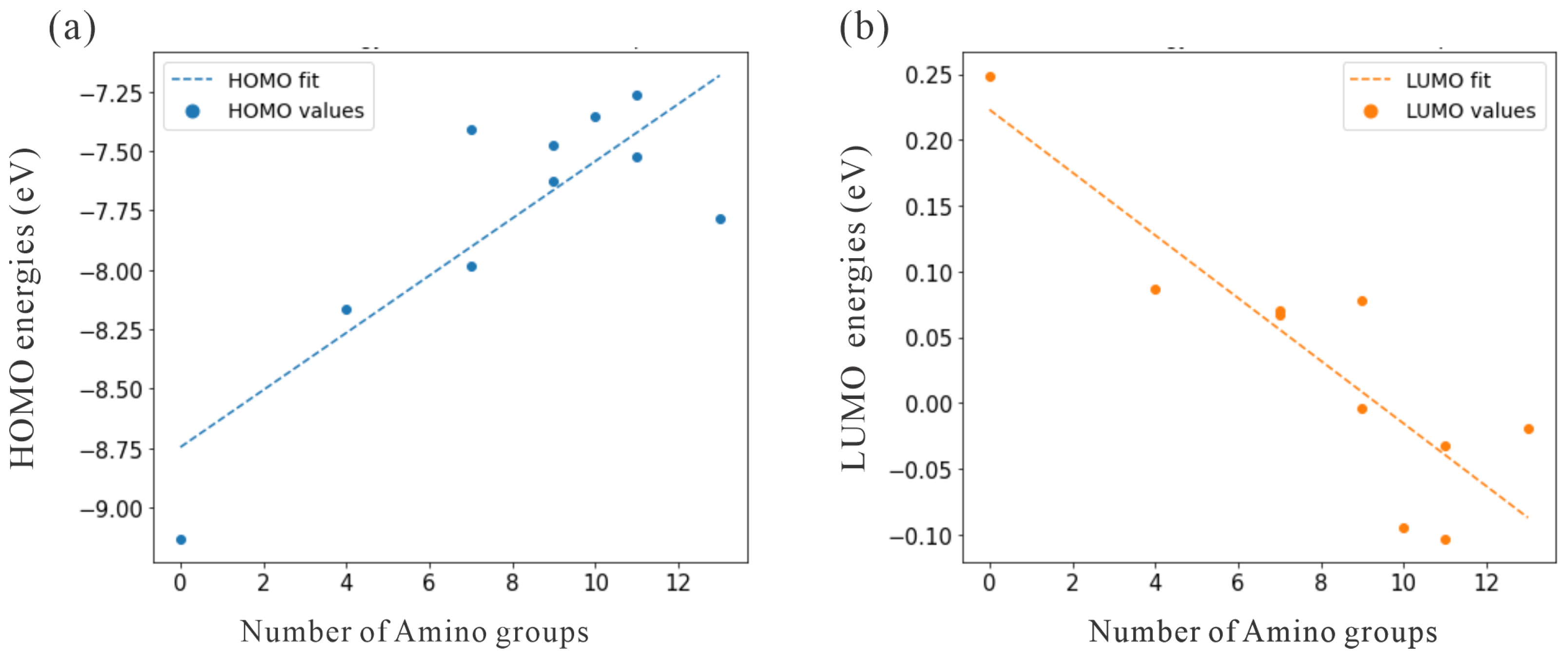
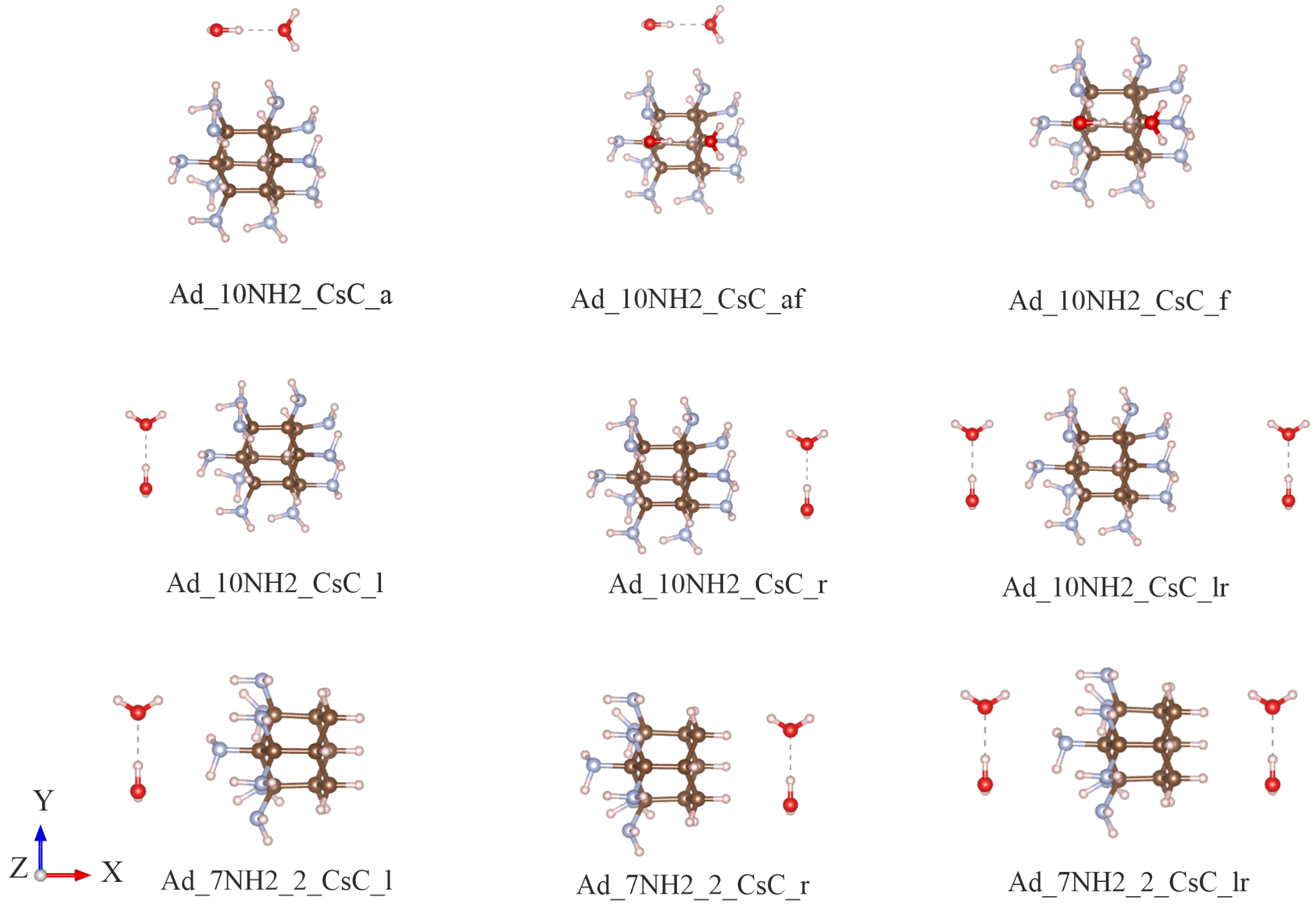

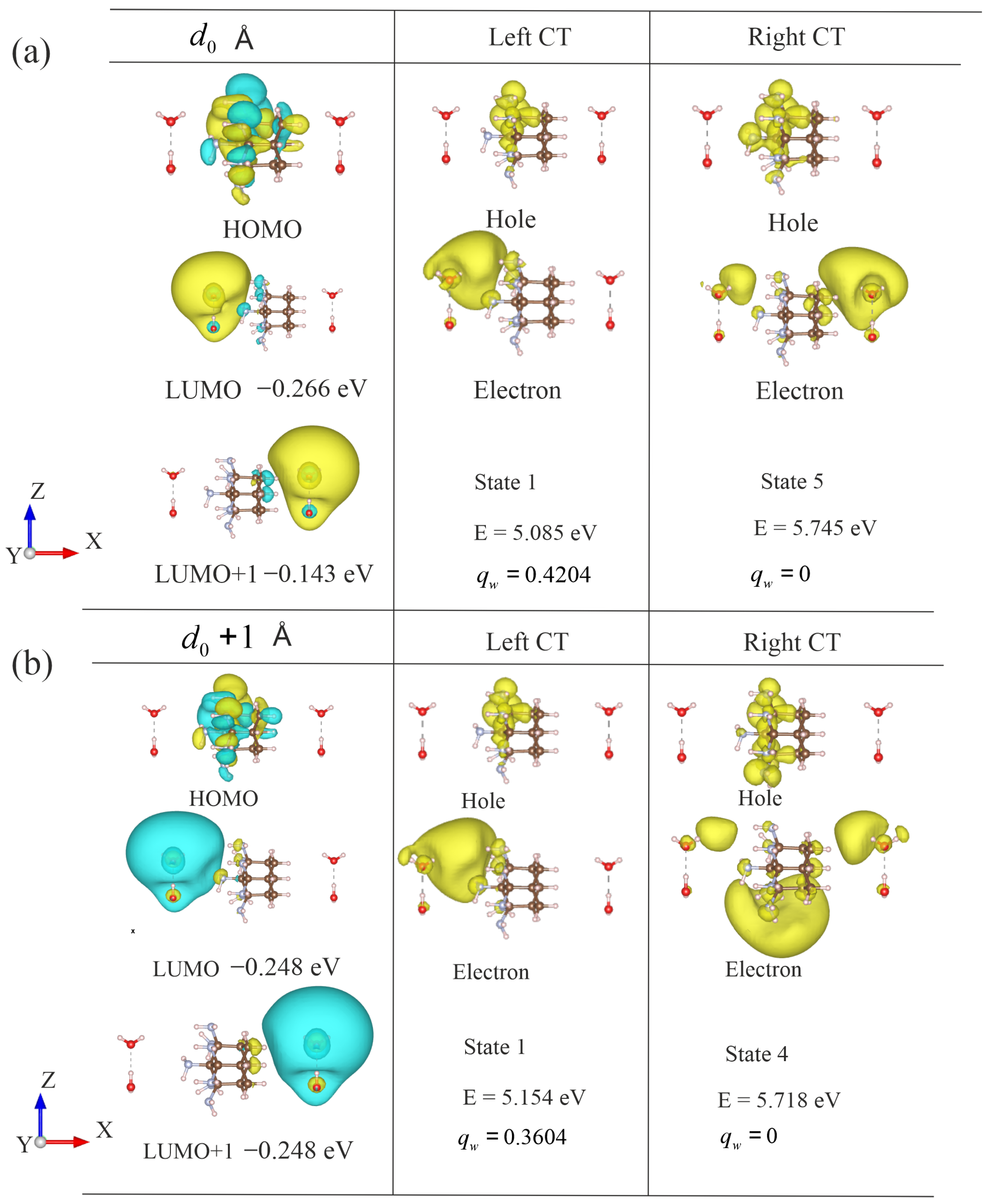
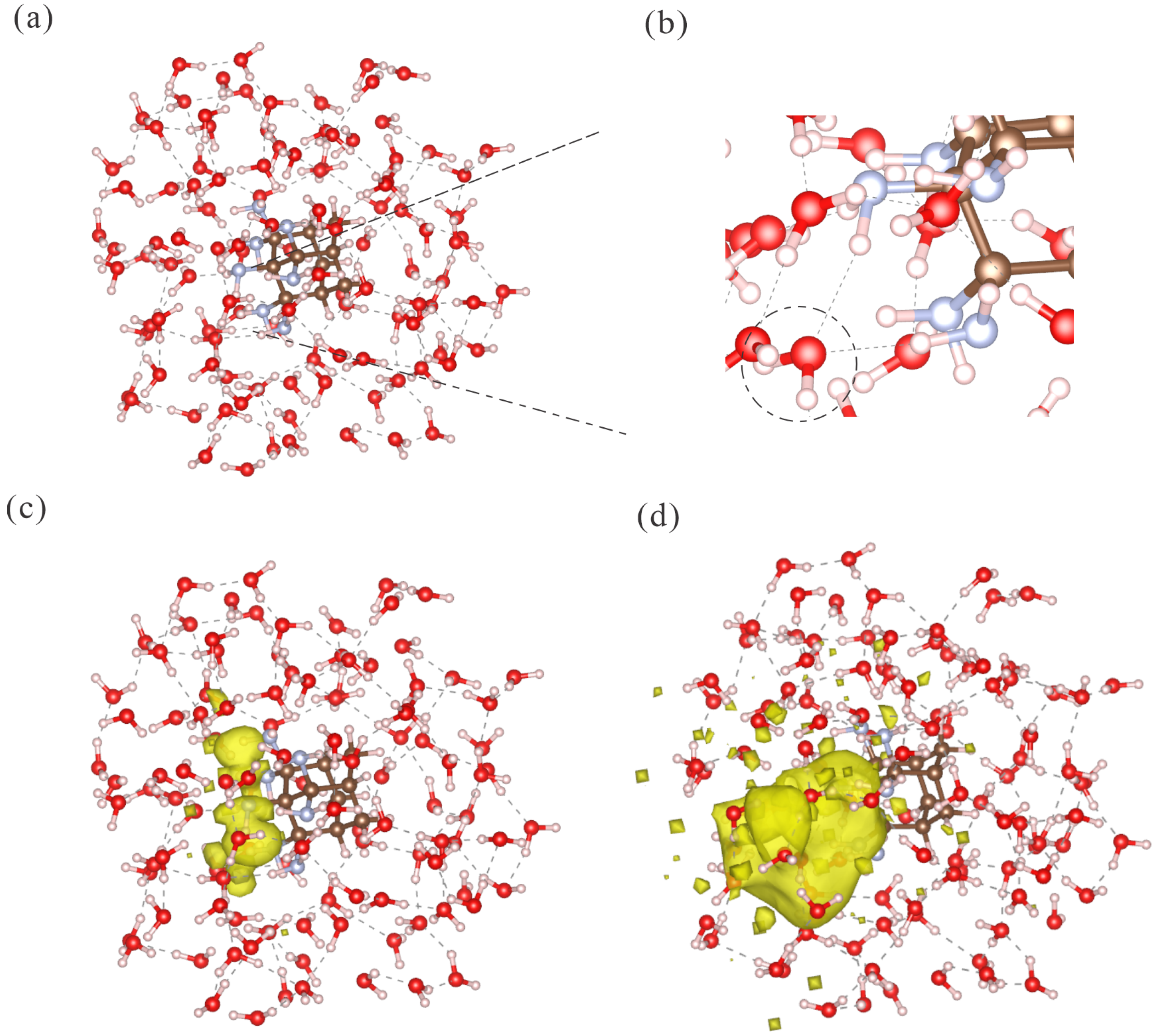
| Molecule | HOMO (eV) | LUMO (eV) | C (e) | H (e) | N (e) |
|---|---|---|---|---|---|
| Ad | −9.131 | 0.249 | −0.122 | 0.082 | 0 |
| Ad_4NH2 | −8.162 | 0.087 | −0.026 | 0.088 | −0.380 |
| Ad_7NH2 | −7.982 | 0.067 | 0.038 | 0.094 | −0.355 |
| Ad_7NH2_2 | −7.410 | 0.070 | 0.022 | 0.091 | −0.355 |
| Ad_9NH2 | −7.473 | −0.004 | 0.060 | 0.094 | −0.344 |
| Ad_9NH2_2 | −7.624 | 0.078 | 0.077 | 0.094 | −0.339 |
| Ad_10NH2 | −7.355 | −0.095 | 0.080 | 0.095 | −0.337 |
| Ad_11NH2 | −7.265 | −0.103 | 0.098 | 0.096 | −0.331 |
| Ad_11NH2_2 | −7.524 | −0.032 | 0.113 | 0.096 | −0.329 |
| Ad_13NH2 | −7.786 | −0.019 | 0.149 | 0.097 | −0.322 |
| Molecule Structures | (eV) | (D) | State | ||
|---|---|---|---|---|---|
| Ad_10NH2_CsC_a | 0.426 | −0.509 | 5.024 | 0.314 | 1 |
| Ad_10NH2_CsC_af | 0.420 | −0.508 | 5.043 | 0.345 | 1 |
| Ad_10NH2_CsC_f | 0.368 | −0.511 | 5.144 | 0.416 | 1 |
| Ad_10NH2_CsC_l | 0.312 | −0.483 | 5.443 | 0.363 | 2 |
| Ad_10NH2_CsC_r | 0.333 | −0.504 | 5.057 | 0.323 | 1 |
| Ad_10NH2_CsC_rl | 0.168 | −0.484 | 5.164 | 0.330 | 1 |
| Ad_7NH2_2_CsC_l | 0.418 | −0.494 | 5.056 | 0.508 | 1 |
| Ad_7NH2_2_CsC_r | 0.546 | −0.549 | 5.705 | 0.193 | 3 |
| Ad_7NH2_2_CsC_rl | 0.418 | −0.494 | 5.071 | 0.516 | 1 |
| CT Left | CT Right | |||||
|---|---|---|---|---|---|---|
| + | (eV) | State | (eV) | State | ||
| 0.0 Å | 0.420 | 5.085 | 1 | 0.413 | 5.745 | 5 |
| 1.0 Å | 0.360 | 5.154 | 1 | 0.160 | 5.718 | 4 |
| 2.0 Å | 0.365 | 5.259 | 1 | 0.254 | 5.818 | 5 |
| 3.0 Å | 0.252 | 5.331 | 1 | 0.118 | 5.891 | 5 |
| 4.0 Å | 0.173 | 6.121 | 7 | 0.156 | 6.170 | 8 |
Disclaimer/Publisher’s Note: The statements, opinions and data contained in all publications are solely those of the individual author(s) and contributor(s) and not of MDPI and/or the editor(s). MDPI and/or the editor(s) disclaim responsibility for any injury to people or property resulting from any ideas, methods, instructions or products referred to in the content. |
© 2025 by the authors. Licensee MDPI, Basel, Switzerland. This article is an open access article distributed under the terms and conditions of the Creative Commons Attribution (CC BY) license (https://creativecommons.org/licenses/by/4.0/).
Share and Cite
Wang, X.; Remmert, J.; Paulus, B.; Bande, A. Efficient Photo-Driven Electron Transfer from Amino Group-Decorated Adamantane to Water. Molecules 2025, 30, 3396. https://doi.org/10.3390/molecules30163396
Wang X, Remmert J, Paulus B, Bande A. Efficient Photo-Driven Electron Transfer from Amino Group-Decorated Adamantane to Water. Molecules. 2025; 30(16):3396. https://doi.org/10.3390/molecules30163396
Chicago/Turabian StyleWang, Xiangfei, Jonathan Remmert, Beate Paulus, and Annika Bande. 2025. "Efficient Photo-Driven Electron Transfer from Amino Group-Decorated Adamantane to Water" Molecules 30, no. 16: 3396. https://doi.org/10.3390/molecules30163396
APA StyleWang, X., Remmert, J., Paulus, B., & Bande, A. (2025). Efficient Photo-Driven Electron Transfer from Amino Group-Decorated Adamantane to Water. Molecules, 30(16), 3396. https://doi.org/10.3390/molecules30163396






